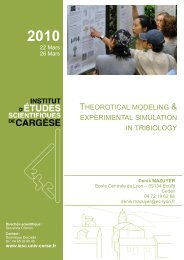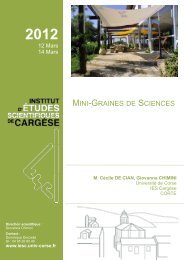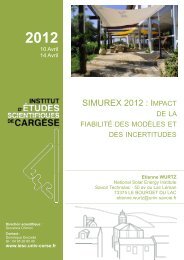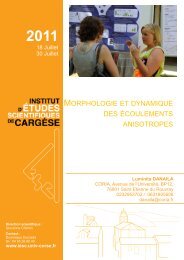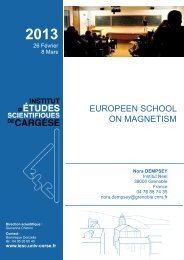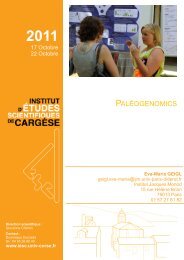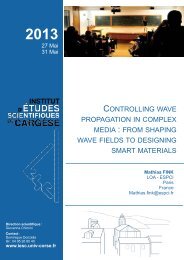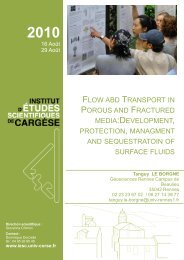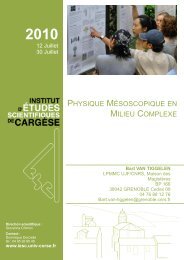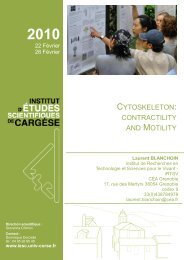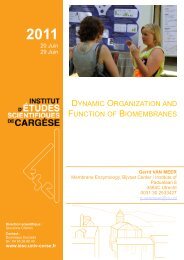nanoelectronics - Institut d'Études Scientifiques de Cargèse (IESC)
nanoelectronics - Institut d'Études Scientifiques de Cargèse (IESC)
nanoelectronics - Institut d'Études Scientifiques de Cargèse (IESC)
You also want an ePaper? Increase the reach of your titles
YUMPU automatically turns print PDFs into web optimized ePapers that Google loves.
Monday<br />
Single-Electron Tunneling and the Fluctuation Theorem<br />
Gerd Schön 1 , Y. Utsumi 2 , D. S. Golubev 1 , M. Marthaler 1<br />
1<br />
<strong>Institut</strong> für Theoretische Festkörperphysik, Karlsruhe <strong>Institut</strong>e of Technology, 76128<br />
Karlsruhe, Germany<br />
2<br />
Department of Physics Engineering, Faculty of Engineering, Mie University, Tsu, Mi-e, 514-<br />
8507, Japan<br />
Experiments on the direction-resolved full-counting statistics of single-electron tunneling<br />
allow testing the fundamentally important Fluctuation Theorem (FT). At the same time, the<br />
FT provi<strong>de</strong>s a frame for analyzing such data.<br />
Here we consi<strong>de</strong>r tunneling through a double quantum dot (DQD) system which is coupled<br />
capacitively to a quantum point contact (QPC) <strong>de</strong>tector. Fluctuations of the environment,<br />
including the shot noise of the QPC, lead to an enhancement of the effective temperature in<br />
the FT. We provi<strong>de</strong> a quantitative explanation of this effect [1].<br />
In addition we discuss the influence of the finite <strong>de</strong>tector bandwidth on the measurements.<br />
Furthermore, we <strong>de</strong>rive the full counting statistics for the coupled DQD - QPC system and<br />
obtain the joint probability distribution of the charges transferred through the DQD and the<br />
QPC, which is consistent with the fluctuation theorem (FT) [2]. The system can be <strong>de</strong>scribed<br />
by a master equation with tunneling rates <strong>de</strong>pending of the counting fields and satisfying a<br />
generalized local <strong>de</strong>tailed-balance relation.<br />
[1] Bidirectional Single-Electron Counting and the Fluctuation Theorem, Y. Utsumi, D.S.<br />
Golubev, M. Marthaler, K. Saito, T. Fujisawa, and G. Schön, Phys. Rev. B 81, 125331 (2010)<br />
[2] Fluctuation theorem for a double quantum dot coupled to a point-contact electrometer,<br />
D.S. Golubev, Y. Utsumi, M. Marthaler, G. Schön, Phys. Rev. B 84, 075323 (2011)<br />
__________________________________________________________________________<br />
Impact of nanophononics on thermoelectricity: measurements and methods<br />
Olivier Bourgeois, Christophe Blanc, Hossein Ftouni, Dimitri Taïnoff<br />
<strong>Institut</strong> Néel, Université Joseph Fourier-CNRS, 25 rue <strong>de</strong>s Martyrs, BP 166, 38042 Grenoble<br />
Ce<strong>de</strong>x 9, France<br />
We will review recent progresses ma<strong>de</strong> in nanophononics to get a better approach in energy<br />
harvesting [1,2]. The manipulation of phonons in low dimensional suspen<strong>de</strong>d structures<br />
opens up very important questions especially at low temperature [3,4]. Different concepts<br />
have been proposed to transform single crystalline materials into phonon glasses: phononic<br />
crystals, suspen<strong>de</strong>d structured membranes, nanoengineered materials. The possible<br />
reduction of phonon transport in these structures by opening a gap in the dispersion relation,<br />
by reducing the group velocities or by <strong>de</strong>creasing the phonon mean free path is a possible<br />
path towards better thermoelectrics.<br />
The measurement of very small suspen<strong>de</strong>d systems requires the <strong>de</strong>velopment of highly<br />
sensitive experimental techniques. We will <strong>de</strong>scribe state of the art experimental methods<br />
that have been proposed for the measurement of tiny energy exchange from room<br />
temperature to very low temperature [5] (thermal conductance measurement and heat<br />
exchange in general). We will show recent experiments that play with phonons at the<br />
nanoscale. To conclu<strong>de</strong> we will see that nanophononics at low temperature is still a very<br />
open subject especially with suspen<strong>de</strong>d systems containing electrons like graphene or two<br />
dimensional electron gas.



